Don't wanna be here? Send us removal request.
Text
W14 - Final Pitching Experience

As we near the end of our venture's journey, Ailyn May Tongol steps up to present our final pitch, embodying our team's growth and determination. We know we're not perfect, but we're proud of the progress we've made leading up to this moment. Our journey has been about learning from challenges and adapting to feedback. Ailyn's calm delivery shows our team's confidence and our commitment to getting better. We're not saying everything is flawless, but we believe we've improved. This final pitch isn't just about showing off our product—it's about sharing our journey, which has been about bouncing back from setbacks and always striving to do better. As Ailyn speaks, we hope to inspire confidence and invite others to join us on our journey to success. We're immensely grateful for the guidance and support provided by our instructor, Ms. Miriam Bergado. Her mentorship has been invaluable in shaping our understanding, refining our strategies, and fostering our growth throughout this venture. Her insights and encouragement have played a pivotal role in our development, and we extend our heartfelt thanks for her unwavering dedication and belief in our team. With her guidance, we've navigated challenges, embraced opportunities, and emerged stronger and more resilient. As we approach the culmination of our journey, we carry with us the lessons imparted by Ms. Bergado, ready to seize the future with confidence and determination.
0 notes
Text
W13 - Launching of Idea

Launching our idea on Facebook has been incredibly helpful for understanding how people are reacting to it. By keeping an eye on our Facebook page's activity—like how many likes, comments, and shares we're getting—we can see if people are interested and if our idea might spread.
One of the best parts about using Facebook is that people can tell us what they think right away. They can leave comments or messages with their thoughts, suggestions, or worries. This is super useful for us because we can learn what people like and what they want us to change about our Loocakes app.
Also, Facebook lets us check out what other similar apps or businesses are doing. We can see how people are reacting to them and figure out what makes us different or better. And with Facebook's tools, we can see how well our posts are doing, so we can keep improving how we're reaching and keeping users.
So, launching on Facebook isn't just about getting users—it's also about learning from them and making our app even better.
0 notes
Text
W12 - Group Updates
Traction Channel
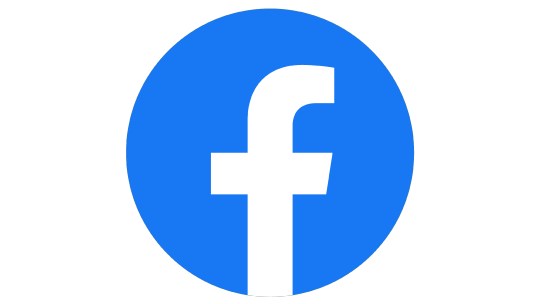
We chose Facebook as our primary traction channel due to its widespread usage and robust engagement features. By creating a dedicated Facebook page for the Loocakes app, we can leverage our existing network to quickly gain followers through friend invites. This page will serve as a hub for sharing our branding videos, updates, and promotions, allowing us to reach a broader audience through shares and interactions. Facebook's targeted advertising options also enable us to efficiently reach potential customers who are interested in homemade baked goods. This strategy ensures that our marketing efforts are both cost-effective and highly impactful, driving user acquisition and engagement for the Loocakes app.
Updated MVP


The updated MVP of the Loocakes app offers a seamless experience for both sellers and customers. Sellers can effortlessly list their cakes, complete with detailed descriptions, attractive photos, and pricing information. The app’s intuitive interface allows sellers to manage orders, track sales, and communicate with customers efficiently. On the customer side, users can easily browse through a diverse selection of cakes, read reviews, place orders, and arrange for delivery or pickup. This high-fidelity MVP has been well-received in customer interviews, with feedback highlighting its simplicity, ease of use, and overall appeal for both sellers and buyers.
Product-Market Fit Customer Discovery
During our product-market fit customer discovery, we conducted extensive interviews and surveys with potential users to understand their needs, preferences, and pain points. This process revealed a strong demand for a solution like Loocakes, confirming that our app addresses a significant market gap. Customers consistently highlighted the app's user-friendly interface, simplicity, and appealing design as major strengths. Their positive feedback and enthusiastic responses have given us confidence that Loocakes meets a genuine market need, aligning well with our target audience's expectations and increasing our likelihood of achieving product-market fit.
0 notes
Text
W11 - Midterm Pitching Experience

As we approach the midpoint of our venture's journey, Ailyn May Tongol, our group handler, is gearing up to deliver our midterm pitch for the Loocakes App. This milestone marks a significant point in our development process, where we reflect on our progress, challenges, and aspirations. While the preparation for this presentation has been both demanding and enlightening, it has provided us with invaluable insights into the strengths and areas for improvement of our venture. The Q&A sessions with the panelists have been particularly illuminating, unveiling opportunities to refine our strategies, enhance our market positioning, and strengthen our value proposition. We've encountered questions that have challenged us, exposing gaps in our understanding and prompting us to reassess our approach.
Looking ahead, we are committed to leveraging this experience to drive our growth and success. We recognize the importance of continuous learning and adaptation, and we plan to capitalize on the feedback and lessons learned from the midterm pitch. By conducting additional customer interviews, refining our product offering, and fine-tuning our presentation skills, we aim to deliver a compelling final pitch that showcases the unique value and potential of the Loocakes App. With determination and resilience, we are confident that we will emerge from this midterm milestone stronger and better positioned to achieve our goals.
0 notes
Text
W6 - WEN Ignite Experience
Throughout this week, our team has been tasked with creating two milestones for our practice venture, the Loocakes App. The primary objective of the WEN Ignite Experience is to enhance our practice venture. This experience serves to rejuvenate our progress in the venture by aligning it with our classroom activities. While crafting our milestones, we follow a recurring process similar to what we undertake during class. However, the beneficial aspect is that our guidelines aim to elevate our venture, making it suitable for an investible pitch deck. This entails ensuring that our practice venture meets the standards for a compelling presentation or pitching practice venture.
From Customer Discovery to the Value Proposition Canvas to Customer Segmentation, we revisit these phases in our venture during the WEN Ignite Experience. Although some aspects, particularly Market Size Estimation, were not covered in class, we possess the knowledge to address them, thanks to supplementary videos available on the website. These resources, particularly the weekly planner page, provide guidance on how to approach such aspects. Overall, the WEN Ignite Experience serves as a comprehensive platform for refining our venture-building skills, ensuring that each milestone we set contributes significantly to the development and presentation readiness of the Loocakes App.
0 notes
Text
W5 - Customer Segments
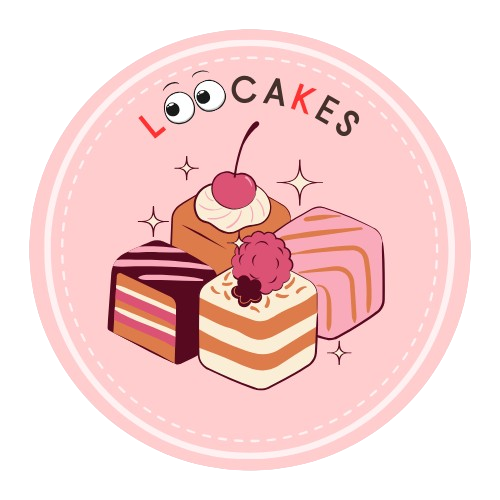
This week, we're starting from scratch and doubling our efforts to catch up with the timeline. Once, one of my teammates and I sought guidance from our Technopreneurship instructor to mentor us and provide recommendations for our team's situation. Thankfully, after the mentorship session, we felt enlightened and uplifted, gaining valuable insights into our future tasks.
Later, one evening, we held a Google Meet with our teammates to brainstorm new ideas. We struggled to come up with something unique at first, as our initial ideas were common. However, after an hour of discussion, we landed on a promising idea centered around cakes.
Following this, we conducted interviews with five individuals this week. Prior to the interviews, we identified three customer segments based on our idea: cake consumers, online cake sellers, and cakeshop owners. Each team member conducted one-on-one interviews with different interviewees, and one of my teammates interviewed two people.
After analyzing the interviews, we ranked the customers based on their responses. We determined that online cake sellers were our top priority, as we believe they stand to benefit the most from our idea. Cake consumers were ranked second, followed by cakeshop owners.
We then developed a Value Proposition Canvas and Business Thesis Template for each customer segment. Among the five interviewees, we selected the online cake seller as the primary persona, given their significance as our top customer segment.
To elaborate, online cake sellers stand to benefit greatly from our idea, as it will expand their customer reach through efficient ordering management and improve sales opportunities compared to traditional methods such as posting cakes on Facebook. Additionally, cake consumers will enjoy the convenience of ordering cakes, transparent pricing, and delivery options. Lastly, cakeshop owners will enhance their online presence by showcasing their cakes and streamlining the ordering process compared to their physical storefronts.
0 notes
Text
W4 - Value Proposition Canvas

Last week, we decided to change our topic because during the previous week's interview, we discovered that the results we gathered did not align with our proposed solution to the issues in the cafeteria. This week, instead of starting from scratch, we decided to stick with our idea, hoping it might still hold promise. Additionally, we altered our strategy for conducting interviews, opting for the Value Proposition Canvas approach, focusing on customers' jobs, pains, and gains, as last week's interviews were not conducted effectively.
This week, we interviewed five random students at USTP, the same number as last week. This time, we refrained from disclosing our solution idea for the cafeteria's problems. Instead, we solely asked about their roles as cafeteria consumers, their positive and negative experiences, and their wishes for cafeteria improvements. This approach allowed us to assess whether our idea could address both positive and negative experiences and fulfill customer desires. It also helped us determine whether to pivot our idea or change it altogether next week.
After the interviews, we realized that our proposed solution might not address the cafeteria's core problems. Most of the issues students faced were related to comfort, such as limited space and overheating, while problems like long queues were not deemed critical to solve. This realization prompted us to start afresh next week, allocating extra time to catch up on the process.
0 notes
Text
W3 - Customer Discovery of your Group Idea

This week, we conducted interviews with five randomly selected students at USTP. The process was challenging for us as we were not accustomed to interviewing individuals we did not know, compounded by the fact that we were all introverted. However, despite the difficulty, we recognized the necessity of these interviews in order to achieve our goal of identifying potential customers for our idea.
During the interview process, to be honest, it was kind of amusing. We didn't dive into the interview right away because we were debating amongst ourselves about who should initiate communication with the random students at USTP. It dawned on us that we had assigned roles, and it's the responsibility of the Hustler of our team to handle communication. Thankfully, our hustler confidently fulfilled his duty without any complaints, and we are proud of him as a fellow introvert. Straight off to the interview, it felt awkward initially since we're not fond of small talk, which is a natural trait of introverts, such as saying "Hello" or "How are you doing?" Especially when talking to someone we don't know, it just feels awkward. Nevertheless, we had to feign enthusiasm and engage in small talk with random students to complete the interview.
We couldn't have imagined that the interview would turn out to be fun and interactive, and we actually enjoyed it. We interviewed random students with various personalities. Among the interviewees, there were two individuals whom we found particularly engaging and enjoyable to converse with. This was because they were talkative and articulate in their responses to our questions, and their energy drew us in, making us eager to continue the conversation. By the end of the interview, we deemed it successful, and we also gained insights and knowledge during the process.
After the interview, upon reflection, we realized that our interview approach was flawed. It's not that we did it entirely wrong, but during our interviews, we tended to introduce our solution or idea regarding the problem we identified at the cafeteria, which was biased. We didn't delve into the issues the interviewees genuinely encounter in their daily lives. We learned that for the next interviews, we need to alter our approach to how we conduct them. Even though this week's interviews followed the wrong approach, we observed that the results we gathered weren't in line with our proposed solution or idea for the problem. Therefore, we decided to start afresh in next week's interviews, changing the topic and revising our questions accordingly.
0 notes
Text
W2 - Problem Exploration and Team Formation
Forming a Team
In the previous week, our instructor assigned us several tests, including the MBTI personality test, the CrackMyCode test, and the Innovation Mindset test. The MBTI personality test results are particularly crucial, as they serve as the main basis for determining which teammates we should collaborate with. My MBTI result is ISFJ-T. Interestingly, our instructor was surprised by the overall outcomes in our section, as the majority of us turned out to be introverted.
This poses a challenge in forming teams, as it is challenging to create balanced teams when most members share similar introverted traits. The instructor emphasized the necessity of having at least one extrovert in each team, given their natural inclination to take on leadership or spokesperson roles. Given the prevalence of introverts in our section, we were left with no choice but to form teams within our own ranks.
In this case, I have found teammates, and essentially, my teammates are my close friends, namely Spencer So, Gregie Alcantara, and Ailyn May Tongol. (Further in this blog, you will find out about our roles in the team.)
During the team formation process, individuals had to adjust and be willing to take on leadership or spokesperson roles, even if it went against their natural tendencies. This requirement aims to ensure a diverse and balanced dynamic within each team.
Roles of the Team
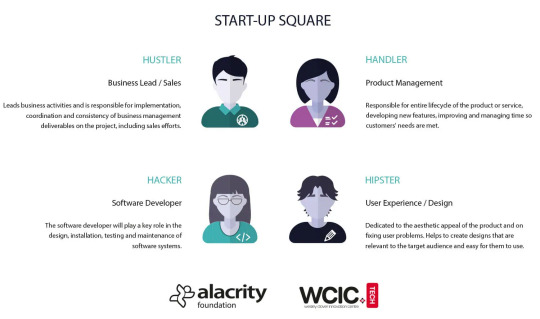
Our instructor granted us the freedom to choose our teammates and form either a 3-member or a 4-member team. Each team member was assigned one of four specific roles: Hustler, Handler, Hacker, or Hipster. The roles were carefully designed to complement each other and contribute to the team's overall success.
The role of the Hustler involves leading the team with confidence and proficiency in pitching ideas. This role is particularly well-suited for individuals who are extroverted, which is why our instructor mandated that at least one team member must be an extrovert to fill this role.
Next is the Hacker, responsible for excelling in software development. The Handler, on the other hand, is adept at managing projects efficiently. Finally, the Hipster specializes in creating GUI designs and ensuring a positive user experience.
Given these distinct roles, each team member's strengths and expertise contribute to the team's collective abilities, fostering a well-rounded and effective collaboration.
Roles Assignment
During this phase, choosing a suitable role for myself and my teammates proves challenging, especially considering we are three introverts with one extrovert in our team. As mentioned earlier, there are four types of roles in a team. When assigning roles, we convened for a meeting via Google Meet to discuss which roles should be assigned to each of us.
In the course of our discussion, my teammate Spencer voluntarily took on the role of Hipster, leveraging his proficiency in designing graphical UI/UX. While I am also skilled in this area, I had no choice as he claimed the role first. Now, three team roles remained, and it was amusing to note that none of us were inclined to take the Hustler role.
Despite Ailyn May having an extroverted MBTI result, she expressed no interest in the Hustler role. Consequently, Gregie stepped forward to assume the Hustler role. Even though he, like me, is introverted, I sensed a hidden ability in him to effectively communicate and interact with people. Following this, Ailyn assumed the Handler role, leveraging her organizational skills, while I took on the Hacker role, acknowledging my proficiency in programming despite not being an expert, as I preferred avoiding the role of being a hustler. 😂
The team roles are now filled,
Spencer So as the HIPSTER, Gregie Alcantara as the HUSTLER, Ailyn May Tongol as the HANDLER, and myself as the HACKER.
Problem Exploration
During problem exploration, each of us searches for problems by conducting interviews with at least five loved ones, family members, or friends to identify the top three issues. In the first interview, the instructor instructs us to focus on people we know. Following the interviews, we formulate a problem based on the findings and propose potential solutions. In class, we collectively brainstorm our identified problems and select the top three, as decided by the group.
On pitch day, Gregie presents our findings and proposed solutions. Following the presentation, we gain numerous realizations.
MY INSIGHTS
I understand why our instructor forms our team based on MBTI results. As an extrovert known to be a team leader and the best communicator in a team, introverts will not take this role as personality is not for that role. Let's break that misconception that introverts will not take the leader role or the communicator role in a team. Many introverts out there are the best communicators and good storytellers and mostly successful people, like Bill Gates.
Even though I am assigned such a role, it doesn't define me that my capability or skills are just right like that. It is just that I am not confident or haven't even tried. But I know to myself that I have something to offer, and I can do things like being a good communicator or taking a role as a Hustler.
In problem exploration, it is hard to search for problems, especially if the problem encountered by the interviewee is very common. As an interviewer, you have to be patient and strive to find problems that exist without solutions or have solutions, but you propose something innovative. When thinking about the solution to a problem, it is important to engage in critical thinking. You have to consider many factors, ensuring the solution is ideal and realistic, even when initially considering it ridiculously. Searching for a problem and its solution is challenging, but it can be done with perseverance and creativity.
0 notes
Text
W1 - Intro to Technopreneurship and Test Results
Getting to know Technopreneurship
While I'm typing this blog post, I've noticed that Grammarly which is an extension for fixing grammatical errors while I type, detects "technopreneurship" as an unknown word. When I look it up in the dictionary, I find that the word "technopreneurship" is not included. Even the Google dictionary doesn't provide a meaning for the word. Based on my Google search, technopreneurship is a combination of "technology" and "entrepreneurship," a term coined by business-minded individuals who rely on technology to start, develop, and make a business venture profitable.
Honestly, I didn't grasp the concept of technopreneurship completely at first. However, as our instructor began the lecture, I gained a much clearer understanding of the subject. The enthusiasm and openness of our instructor in class made the learning experience exciting for me. While the instructor is a bit strict, I find it to be a positive aspect, and overall, I appreciate the course. Technopreneurship, for me, is an essential subject that prepares students who aspire to become entrepreneurs in the future, particularly those inclined to leverage technology in their ventures.
My Test Results
- MBTI Personality Test -
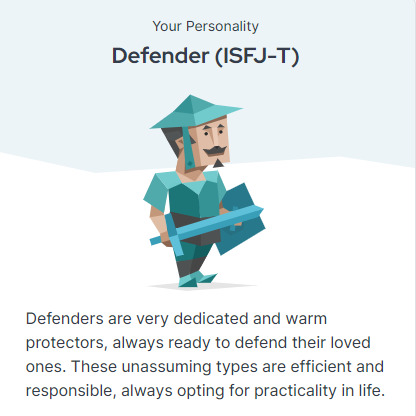
Actually, I am shocked by my latest personality test. Not too long ago, probably when I was in senior high, I took a personality test on the same website. I distinctly remember that my result was INFJ-T back then. However, upon retaking the test now, I am identified as an ISFJ-T. According to my latest results, I have become more observant compared to what I remembered. In the past, I recall being more on the intuitive side, but the other traits remain the same.
- Bank Code Personality Report -
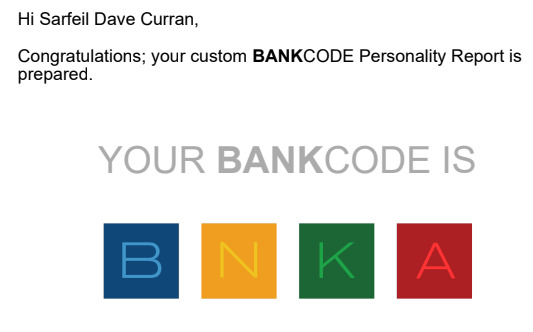
BNKA stands for Blueprint - Nurturing - Knowledge - Action. Each letter has its list of corresponding values. In taking the test, I prioritized the Blueprint card first, followed by the Nurturing card, then the Knowledge card, and lastly, the Action card, resulting in the acronym BNKA. The outcome suggests a trustworthy and responsible individual that many people can depend on.
Based on that report, I believe it's not sufficient to categorize me solely as a trustworthy and responsible person that others can depend on. The results seem somewhat limited but are also considerate, recognizing that tests are theoretical and can provide insights that may align with our true selves. Ultimately, we are the ones who truly know who we are.
- Innovation Mindest Evaluation -

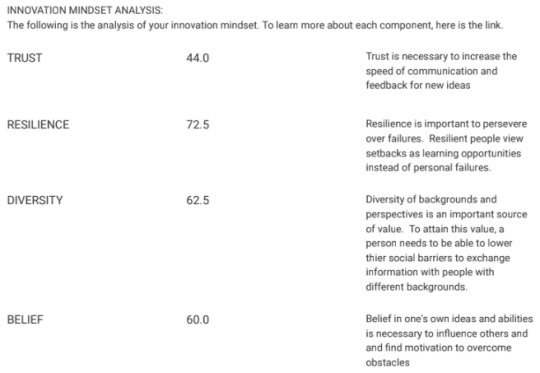
In this test, my results were mediocre. My Personal Innovation Mindset Level is currently 58.62% out of 100%. In my innovation mindset analysis, my trust is at 44%, resilience at 72.5%, Diversity at 62.5%, and Belief at 60%. The lowest percentage I received is for trust, and reflecting on it, it seems somewhat accurate for me since I tend to lack trust in other people. The result suggests that I must trust others more to enhance the speed of communication and feedback for new ideas.
On the other hand, the highest percentage I achieved is for resilience, which resonates with me as an individual. I view my failures as learning opportunities, a chance to grow and become a better version of myself.
Final Thoughts
The tests I have taken, including the MBTI and Innovation Mindset Evaluation, are inherently theoretical. While some results resonate with me as an individual, they don't definitively define who I am because they are subjective rather than objective. I believe that personality and traits can evolve over time; in essence, people change. However, certain aspects of our personality and traits may endure, becoming integral parts of our character. Despite this, it's crucial to recognize that these tests offer a subjective perspective on our personalities from someone else's viewpoint.
1 note
·
View note